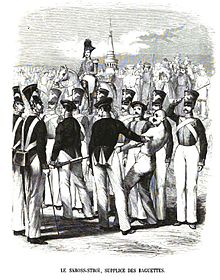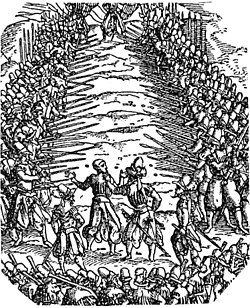Gauntlet in Russia, 1845
To run the gauntlet is to take part in a form of corporal punishment in which the party judged guilty is forced to run between two rows of soldiers, who strike out and attack him.
Etymology and spelling
The word originates from Swedish: gatlopp, from gata "lane" and lopp "course, running".[1] It was borrowed into English in the 17th century, probably from English and Swedish soldiers fighting in the Protestant armies during the Thirty Years' War. The word in English was originally spelled gantelope or gantlope, but soon its pronunciation was influenced by the unrelated word gauntlet, meaning an armored glove, derived from the French: gantelet. The spelling changed with the pronunciation. Both senses of gauntlet had the variant spelling gantlet. For the punishment, the spelling gantlet is preferred in American English usage guides by Bryan Garner and Robert Hartwell Fiske and is listed as a variant spelling of gauntlet by American dictionaries. British dictionaries label gantlet as American.
Predecessor in antiquity
Known as Xylokopia in Ancient Greece, used as a severe military punishment and Fustuarium (a Latin abstraction from the Latin fustis, a branch or rod) in the Roman military as a form of execution by cudgeling (clubbing).
It could also be applied to every tenth man of a whole unit as a mode of decimation.
Post-Roman usage
Spiessgasse (pike-alley), from the Frundsberger War Book of Jost Amman, 1525
A very similar military punishment found in later armies was known as
"running the gauntlet". The condemned soldier was stripped to the waist
and had to pass between a double row (hence also known as die Gasse, "the alley") of cudgeling or switching comrades. A subaltern
walked in front of him with a blade to prevent him from running. The
condemned might sometimes also be dragged through by a rope around the
hands or prodded along by a pursuer.
Various rules might apply, such as banning edged weapons,
requiring the group to keep one foot in place, or allowing the soldier
to attempt to protect his head with his hands. The punishment was not
necessarily continued until death. If so, he might be finished off when
unable to walk or if he managed to reach the end of rows. Running the
gauntlet was considered far less of a dishonor than a beating (with
exposure to ridicule) on the pillory, pranger, or stocks, since one could "take it like a man" upright and among soldiers.
In some traditions, if the condemned was able to finish the run
and exit the gauntlet at the far end, his faults would be deemed paid,
and he would rejoin his comrades with a clean slate. Elsewhere, he was
sent back through the gauntlet until death.
- A Prussian cavalry variation was to beat the condemned with stirrup straps instead of rods.
- It was also common practice in the French army, especially for thieves.
- Also used in training, notably on military cadets, as in a scene in the movie Oberst Redl.
- There was also a naval version of the gauntlet, notably used in the Royal Navy as a punishment for minor offences such as leaving the crew berths in an unsanitary state, or failing to return on time from leave. The condemned was ordered to make a prescribed number of circuits around the ship's deck, while his shipmates struck him with improvised versions of the cat o' nine tails. Runs of the gauntlet could also be preceded by a dozen lashes from the boatswain's cat o' nine tails, so that any subsequent blows from the crew would aggravate the lacerations on his back. The effectiveness of the punishment would somewhat depend on the popularity of the sailor being punished, and the seriousness of the offence. In 1760 Francis Lanyon, a seaman aboard the guardship HMS Royal George, was sentenced to three runs of the gauntlet, for failing to return from leave. The crew clearly disagreed with the punishment, as the ship's lieutenant later recorded that Lanyon received no substantive injury from the process. The naval punishment of running the gauntlet was abolished by Admiralty Order in 1806.
- Mild forms, not intended to cause permanent damage, have also been used on or by children.
In the early records of the Dutch colonial settlement of New Amsterdam
appears a detailed description of running the "Gantlope/Gantloppe" as a
punishment for the "Court Martial of Melchior Claes" (a soldier). It
states "... The Court Marshall doe adjudge that hee shall run the
Gantlope once the length of the fort, where according to the Custome of
that punishment the souldyers shall have switches delivered to them with
which they shall strike him as he passes through them stript to the
wast, and at the fort gate the Marshall is to receive him and there to
kick him out of the Garrison as a cashiered person where hee is no more
to returne ..."
In Sweden, running the gauntlet was also a civilian punishment
for certain crimes until the 18th century. The practice also persisted
in parts of Germany (mainly Prussia) and Austria as the Spießrutenlaufen, or "pike-run", and also in Russia, until the 19th century.
In popular culture
A notable description of the process appears in Tolstoy's short story "After the Ball"; it is also depicted in Stanley Kubrick's film Barry Lyndon. In Ernest Hemingway's For Whom The Bell Tolls, the aristocrats of the town are subjected to a form of the gauntlet wherein they are led to and run off a cliff by villagers.
An example of the Royal Navy's variation of the gauntlet can be seen in the Hornblower film The Examination for Lieutenant,
wherein Acting Lieutenant Hornblower and Matthews take the role of
Master-at-Arms and Corporal and lead a sailor through the Gauntlet. The
sailor in question was carefully guided through by swordpoint - one
sword ahead of him (Hornblower's) to ensure that he did not rush through
the Gauntlet, and one sword at his back (Matthews') to ensure he did
not run away and was also moved through the Gauntlet. The film shows the
lacerations caused by the knittles were effective, with blood running
freely down the condemned man's back by the time a halt to the process
was called for by Captain Sir Edward Pellew.
In Outlander season 4, Young Ian Murray and Roger Wakefield both run the gauntlet for the Mohawk to determine if they are adopted into the tribe, or must remain prisoners.
Native American usage
A captive runs the gauntlet between Shawnee warriors.
A number of Native American tribes of the Eastern Woodlands culture area forced prisoners to run the gauntlet (see Captives in American Indian Wars). The Jesuit Isaac Jogues was subject to this treatment while a prisoner of the Iroquois in 1641. He described the ordeal in a letter that appears in the book The Jesuit Martyrs of North America:
"Before arriving (at the Iroquois Village) we met the young men of the
country, in a line armed with sticks...", and he and his fellow
Frenchmen were made to walk slowly past them "for the sake of giving
time to anyone who struck us."
Modern use
The original meanings of the phrase notwithstanding, the expression (to run) the gauntlet
has been applied to various less severe punishments or tests, often
consisting of consecutive blows or tasks endured sequentially and
delivered collectively, especially by colleagues such as roommates or
fraternity brothers. As these do not usually cause serious injuries,
only bearable pain, the rituals are sometimes eagerly anticipated by the
initiate as a sign of acceptance into a more prestigious group. Because
of this, Running the gauntlet is considered a Hazing ritual.
The phrase running the gauntlet has also been used, informally, to express the idea of a public but painless, ritual humiliation such as the walk of shame or perp walk, or to indicate a series of difficult trials that one must overcome. It is sometimes confused with the phrase run the gamut.
Fitness trail in communist Poland
During the days of the People's Republic of Poland, the Communist
authorities forced political dissidents, criminals, protestors, and
prisoners through a gauntlet-like process, which they called the "ścieżka zdrowia" (literally health path, but idiomatically used to mean early fitness trails).
In KOR, A History of the Worker's Defense Committee in Poland, 1976–1981, Jan Józef Lipski documents the experience of one such criminal during the June 1976 protests:
On the first day I walked the "path of health" on the way from a truck to the police van, about 50 metres. They ordered me to walk slowly so that each one could hit me. They beat me with fists, clubs, boots. At the very end, I fell down. I couldn't get up again under the hail of clubs... A "path of health" from the van to the second floor... When they took us to get haircuts – another "path of health" some 40 metres long, from the door of the room all the way to the car... Yet another 10 metres in the corridor leading to the table... Then, a "path of health" (10 meters) to cell number nine... to the court in a prison truck; of course another "path of health"... then again a "path" from prison to prison. I survived another "path of health" in the morning when they took me to Kielce.
— Waldemar Michalski
Military custom
Similar practices are used in other initiations and rites of passage, as on pollywogs (those passing the equator for the first time;
includes a paddling version) or in aviation when a new pilot gets their
first license. It has also been used to "tack on" a recently promoted
enlisted person's rank insignia.
In one Tailhook Association convention for Navy and Marine Corps pilots, female participants were allegedly forced to run the gauntlet in a hotel hallway as male participants fondled them.
Sports
- In Brazilian Jiu-Jitsu when a student is promoted to their next coloured belt, they are sometimes required to run between two rows of their fellow students as they are struck by them with their own belts.New belt promotion being celebrated by running the gauntlet of belts.




